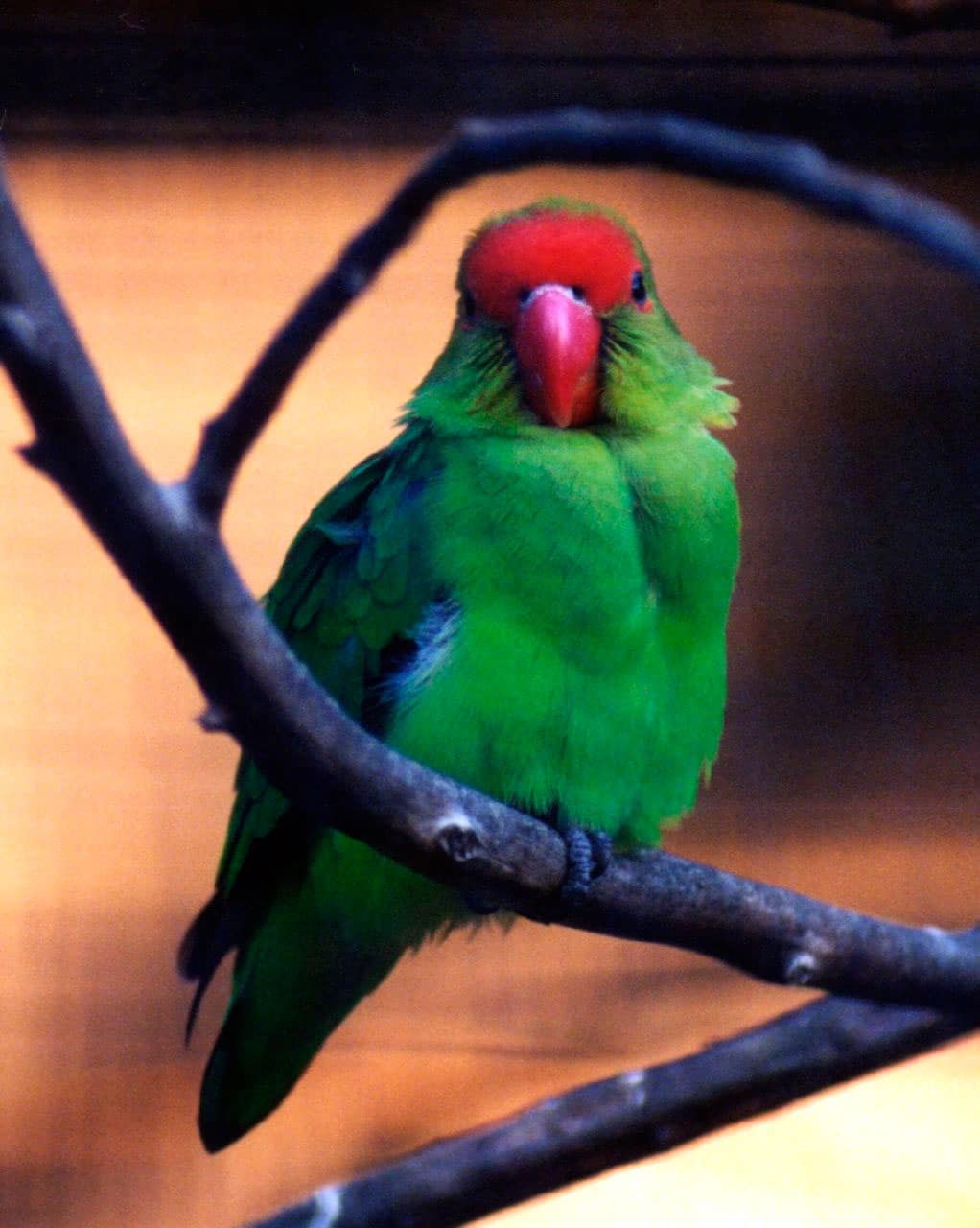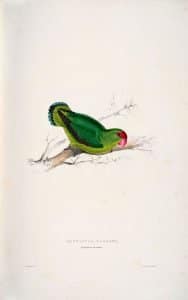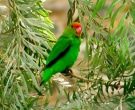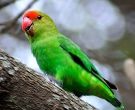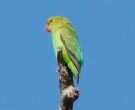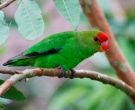Content |
|---|
Description Inseparable Abyssinian:
Of 16 cm in length and a weight between 49 and 66 g..
The Black-winged Lovebird (Agapornis taranta) has the forecrown, lores and feathers eye ring, red; rest of the head and nape green dyed brown. Mantle and green scapulars, rump and uppertail-coverts brighter green. Upper, the wing-coverts green with the exception of coverts outer primaries that they are black. Primaries blackish brown with a narrow green margin towards the vane outer; secondaries black. Under, the wing-coverts black. Chin and throat pale green tinged brown; rest of the underparts pale green. Central feathers of the tail green with toes in black, the green side with yellow in vane inner, subterminal black bar with green tips.
Bill red; irises dark brown; legs grey.
The female no red in the head, and feathers sometimes under the wings marked in green.
The immature are like females, with the bill yellowish. The Immature males show the color black feathers under the wings with red feathers scattered on the forehead.
Partially sympatric and very similar to Red-headed Lovebird (Agapornis pullarius) with which it has an throat red or orange (no verde) and rump blue (no verde). Usually found in small flocks on the tops of tall trees, where the plumage It blends well with the foliage. Its flight It is fast and direct.
Proposal subspecies Agapornis Taranta nanus (Southwest of Ethiopia) supposedly in bill smaller and wings shorter, but generally not accepted. Birds at higher altitudes are larger, but not subspecifically recognized. monotypic.
- Sound of the Black-winged Lovebird.
Inseparable habitat Abyssinian:
The Black-winged Lovebird, at high altitudes (1.800-3.800 m), They are linked, normally, mountain forests dominated Podocarpus, Juniperus, Hagenia and Hypericum; below , on the 1.400 m, They found in grassy savannas and forests Acacia, Combretum and Euphorbia; also frequent cultivated areas and peripheries of urban areas Addis Ababa.
gregarious, at least out of breeding season, when usually they found in small flocks (8-20) on the tops of the tallest trees, gathering in greater numbers when food is locally plentiful.
Used communal roosts in tree cavities (often old nests woodpeckers or bearded ethiopian).
Sometimes it associated with Yellow-fronted Parrot.
Occasionally they lie face down on captivity.
Playing black-winged lovebird:
The Black-winged Lovebird nest in tree cavities, in holes in walls and even in nests of some Baglafecht Weaver.
In captivity, female leads Nesting material (small pieces of branches, leaves and grass) put in almost any part of their plumage.
The Black-winged Lovebird it's the only one Lovebirds using their own pens to build nest.
The breeding season, according to sources, It between March and November. It is not clear if the egg laying is synchronized with the rainy season. Normally, starting up five eggs, but they can reach eight captive.
Inseparable Power Abyssinian:
The diet release of the Black-winged Lovebird It consists mainly fruit, including Ficus figs and berries juniper.
Perform seasonal movements in relation to food availability.
Distribution:
The Black-winged Lovebird They are endemic to the highlands of Ethiopia from the South of Eritrea through the Harari Region and Addis Ababa including Great Rift Valley.
Frequently in montane forests: relatively uncommon at low altitudes in savanna areas.
Conservation:
• Current Red List of UICN: Least concern
• Population trend: Increasing
The Black-winged Lovebird It is not globally threatened, although it is included in Appendix II (Anexo B) of the CITES Convention.
It has a very small distribution area, so you have a greater risk of extinction because if their habitat is destroyed or uncontrolled catches are made can lead to extinction.
considered as crop pest in some areas, though not of great importance, they can become the object of chemical fumigations to avoid their attacks.
However they are more frequent since 1989, perhaps due to reduced sales of this species for the pet trade.
In the news they are not considered endangered, but we must not fail to protect them and avoid both habitat destruction and illegal capture.
The Inseparable Abyssinian in captivity:
Although not as common as other species of Lovebirds (Rosy-faced Lovebird or the Yellow-collared Lovebird), this handsome Lovebirds It has a very pleasant disposition.
They are more tolerant with others Lovebirds, provided they have enough space, and they are one of the least noisy species.
Dwelling, on freedom, high mountain areas, It is not surprising that the Black-winged Lovebird I can tolerate ambient outdoor aviary, as long as they stay out of drafts and temperatures are not too extreme.
birds are relatively resistant, similar to Fischer's Lovebird or the Yellow-collared Lovebird, although they are not as much as Rosy-faced Lovebird.
typical in all Lovebirds, the Black-winged Lovebird is very sociable and loves the companionship. Their natural behavior is to live closely with a partner / a.
Despite being a very sociable pet and tender, they will need a lot of attention if kept separate. The majority They are kept in pairs to satisfy his great need for constant companionship, acicalamiento mortgage, and socialization.
For reproduce in captivity You need tranquility and a spacious and equipped cage at least two nest boxes.
With regard to its longevity, according to sources, a living specimen 14,6 years in captivity. In captivity, these animals are known to breed, approximately, to the 2 years of age.
Alternative names:
– Black-winged Lovebird, Abyssinian Lovebird, Black winged Lovebird (English).
– Inséparable d’Abyssinie, Inséparable à ailes noires, Inséparable taranta (French).
– Tarantapapagei (German).
– Inseparável-de-asa-preta (Portuguese).
– Inseparable Abisinio, Inseparable de Frente Roja, Agapornis Taranta (español).
scientific classification:

– Order: Psittaciformes
– Family: Psittaculidae
– Genus: Lovebirds
– Scientific name: Agapornis taranta
– Citation: (Stanley, 1814)
– Protonimo: Psittacus taranta
Images Black-winged Lovebird:
Videos "Black-winged Lovebird"
“Black-winged Lovebird” (Agapornis taranta)
Sources:
– Avibase
– Parrots of the World – Forshaw Joseph M
– Parrots A Guide to the Parrots of the World – Tony Juniper & Mike Parr
– Birdlife
– Photos:
(1) – Agapornis taranta – Black-winged Lovebird in the San Diego Wild Animal Park, California By Carlos Urdiales [CC BY-SA 2.0], via Wikimedia Commons
(2) – A male Black-winged Lovebird in a guava tree (eating semiripe) guavas, in Bahir Dar, Ethiopia By Veli Pohjonen (Own photographing in Bahir Dar, Ethiopia) [Public domain], via Wikimedia Commons
(3) – A female Black-winged Lovebird in Ethiopia By Alastair Rae from London, United Kingdom (Black-winged Lovebird) [CC BY-SA 2.0], via Wikimedia Commons
(4) – Inseparable from Abyssinia by avicue
(5) – Black-winged lovebird by mundoexotics
(6) – A painting of a male Black-winged Lovebird (also known as Abyssinian Lovebird) (originally captioned “Psittacula panic. Abyssinian parrakeet”) by Edward Lear 1812-1888 [Public domain], via Wikimedia Commons
– Sounds: Andrew Spencer (Xeno-canto)
